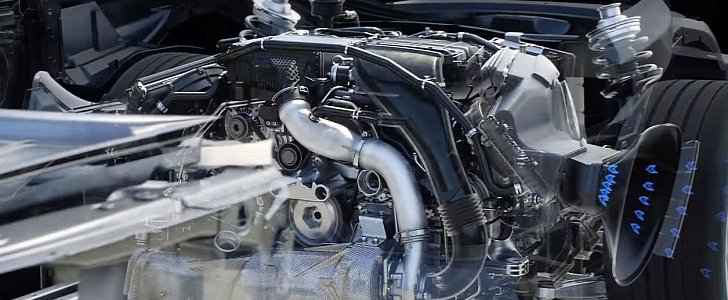Given the traditionally limited styling alterations brought by the mid-cycle boost of the Porsche Boxster, it's not difficult to focus on the tech side that leads the changes offered by the 718 Boxster. And thanks to a tech-fetish animation offered by Zuffenhausen, we can now go inside the 2.5-liter flat-four in the 718 Boxster S.
The first thing you'll notice while watching this clip is how low the engine is mounted, but this is only a detail.
The focus here lies on the digital dissection of the powerplant. We're talking about a 2.5-liter boxer unit that delivers 350 hp and 309 lb-ft (420 Nm), with the forced feeding allowing the peak torque to be delivered between 1,950 and 4,500 rpm.
The new figures can be translated into an increase of 35 hp and 43 lb-ft (58 Nm) compared to what the naturally aspirated flat six of the now-replaced Boxster S.
Thanks to that, the 718 Boxster S is 0.5 seconds quicker to 60 mph (0-97 km/h), completing the sprint in 4 seconds flat (no boxer engine pun intended). And yes, you number junkies, that makes it quicker than BMW's M2.
Since superior fuel efficiency was the reason the Boxster went turbo, we have to mention the sportscar is now about 13 percent less thirsty than before.
Using the European NEDC test cycle, we find out the Boxster S now returns 32 mpg (7.35 l/100 km) on average, but we'll have to wait for the EPA results for a number that's closer to what you'll get in real life.
The main trick of the new 2.5-liter unit is the variable turbo geometry. While the 911 Turbo uses this since the 997 generation (not on the new Carrera/Carrera S, though), the only other production car that comes with such a feature (for gasoline engines) is built by Koenigsegg.
However, we'll remind you Porsche has already patented a variable compression ratio system. Once the tech solution makes it into a production engine, we'll see notions such as "turbo lag" and "limited high-rpm efficiency" receiving a new, diminutive, meaning.
The focus here lies on the digital dissection of the powerplant. We're talking about a 2.5-liter boxer unit that delivers 350 hp and 309 lb-ft (420 Nm), with the forced feeding allowing the peak torque to be delivered between 1,950 and 4,500 rpm.
The new figures can be translated into an increase of 35 hp and 43 lb-ft (58 Nm) compared to what the naturally aspirated flat six of the now-replaced Boxster S.
Thanks to that, the 718 Boxster S is 0.5 seconds quicker to 60 mph (0-97 km/h), completing the sprint in 4 seconds flat (no boxer engine pun intended). And yes, you number junkies, that makes it quicker than BMW's M2.
Since superior fuel efficiency was the reason the Boxster went turbo, we have to mention the sportscar is now about 13 percent less thirsty than before.
Using the European NEDC test cycle, we find out the Boxster S now returns 32 mpg (7.35 l/100 km) on average, but we'll have to wait for the EPA results for a number that's closer to what you'll get in real life.
The main trick of the new 2.5-liter unit is the variable turbo geometry. While the 911 Turbo uses this since the 997 generation (not on the new Carrera/Carrera S, though), the only other production car that comes with such a feature (for gasoline engines) is built by Koenigsegg.
However, we'll remind you Porsche has already patented a variable compression ratio system. Once the tech solution makes it into a production engine, we'll see notions such as "turbo lag" and "limited high-rpm efficiency" receiving a new, diminutive, meaning.


